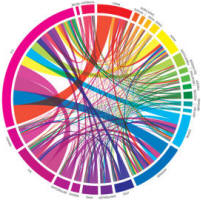 The
old adage about a picture being worth a thousand words is validated often with charts and graphs made for
science, engineering, and finance. This chart illustrates levels of collaboration between 25 countries on scientific
papers published in 2011 in a select group of journals. Author John Sexton uses color and line width to indicate origin
and volume between countries. Circumferential length (pie slice) is relative volume overall. He also includes a similar chart
showing internal collaboration within the 10 countries with the highest scientific paper output. Per Mr. Sexton,
in 1996 about 25% of scientific articles were authored by people in two or more countries; today it is 35%.
Non-commercial "Big Science" projects like the Large Hadron Collider (LHC) at CERN, with multinational funding,
contribute largely to the increase. Aptly pointed out is how global access to and distribution of information has
vastly accelerated the rate of invention and productivity. Sovereignty is still necessary to safeguard defense and financial
competitiveness, but it should not restrict collaboration between willing participants otherwise. Even
self-identified "no borders" people tend to safeguard their own interests by constructing social, political, and
economic boundaries around their work. That goes for collaborators as well as for individual researchers. When it
comes to themselves, being an "idea capitalist," as Sexton puts it, is OK, but everybody else should openly share. The
old adage about a picture being worth a thousand words is validated often with charts and graphs made for
science, engineering, and finance. This chart illustrates levels of collaboration between 25 countries on scientific
papers published in 2011 in a select group of journals. Author John Sexton uses color and line width to indicate origin
and volume between countries. Circumferential length (pie slice) is relative volume overall. He also includes a similar chart
showing internal collaboration within the 10 countries with the highest scientific paper output. Per Mr. Sexton,
in 1996 about 25% of scientific articles were authored by people in two or more countries; today it is 35%.
Non-commercial "Big Science" projects like the Large Hadron Collider (LHC) at CERN, with multinational funding,
contribute largely to the increase. Aptly pointed out is how global access to and distribution of information has
vastly accelerated the rate of invention and productivity. Sovereignty is still necessary to safeguard defense and financial
competitiveness, but it should not restrict collaboration between willing participants otherwise. Even
self-identified "no borders" people tend to safeguard their own interests by constructing social, political, and
economic boundaries around their work. That goes for collaborators as well as for individual researchers. When it
comes to themselves, being an "idea capitalist," as Sexton puts it, is OK, but everybody else should openly share.
Another statistic mentioned is that the United States' dominance in patents issued by the U.S. Patent and
Trademark Office (USPTO) ended in 2008. As manufacturing and
research continues to move offshore, so does the origin of invention. A country's status in the world is based on
a lot of things, among the top of which is scientific contribution. Money follows invention, as is evidenced by
venture capital on a corporate scale and the relatively new crowdsourcing phenomenom on a personal scale.
America's slice of the pie is contracting, much to the delight of many people, including, unfortunately, many of
our own citizens. Our schools are droppping in global rankings, productivity levels are decreasing, and our dollar
is being devalued by unfettered monitization (electronic and physical printing). Aforementioned politicians and
uninvested layment seem bent through both malice and ignorance on knocking the U.S. off its pedestal. We're
teetering now; will we continue to sleep and be toppled, or will we finally wake up and restore the once-great
leadership role we once had? BTW, there is
also a good article titled, "Why Germany Still Makes Things" worth reading. Unfortunately, a subscription is
needed to read the entire article, but you can get a copy from your local library. Of course you can always
subscribe to Scientific American; I look forward to my copy each month. If you read a couple of the comments
posted by readers, some lament the loss of depth of the articles compared to when they first started reading
decades ago. The irony is that obviously their depth of knowledge has increased, not necessarily that the
magazine's content has decreased. That is the case with me as well since when I began reading Scientific American
back in the late 1970s, the concept of quarks, quantum mechanics, astrophysics, genetics, biology, psychology, and
many other realms of study was completely new and I was mesmerized by the data begin presented. Today, I am no
expert in any of the fields but I do find some of the material does not have quite the "wow" factor as before.
However, there is always something new and worth reading. Posted September
21, 2012 |








